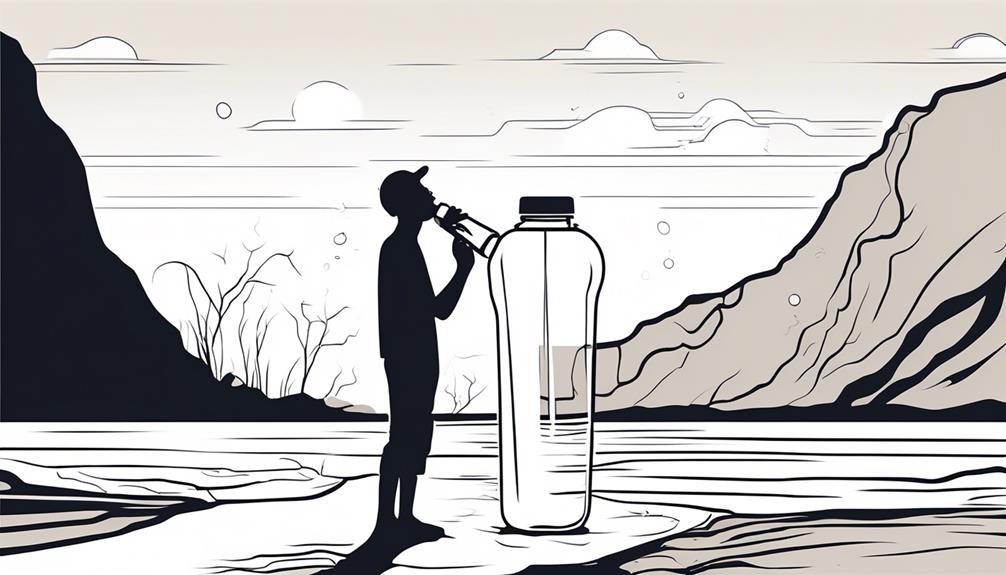Just like a ripple effect that spreads across a pond, water scarcity has far-reaching consequences on human health. Imagine the intricate web of interconnected factors where inadequate access to clean water not only affects daily hydration but also impacts the prevalence of diseases and the overall well-being of communities.
In this guide, you will uncover the intricate ways in which water scarcity intertwines with health outcomes, shedding light on the urgency of addressing this global challenge. From examining the link between water stress and disease to exploring strategies for mitigating its effects, this comprehensive guide will provide you with a deeper understanding of how water scarcity intricately weaves into the fabric of public health.
Key Takeaways
- Limited access to clean water in water-scarce areas increases the risk of waterborne diseases like diarrhoea and cholera.
- Inadequate sanitation practices exacerbate the prevalence of waterborne diseases, highlighting the importance of proper hygiene in such environments.
- Climate change intensifies water scarcity, escalating waterborne diseases and emphasizing the need for improved water management strategies.
- Addressing water access disparities, investing in modern water infrastructure, and implementing regulatory standards are crucial steps in combating the health impacts of water scarcity.
The Link Between Water Scarcity and Disease
Water scarcity's impact on health is starkly evident in the direct correlation between limited access to clean water and the rise of waterborne diseases like diarrhoea and cholera. When communities lack sufficient water resources, the risk of consuming contaminated drinking water increases significantly. Poor sanitation practices further compound the issue, leading to a higher prevalence of waterborne diseases that pose serious health risks to the population.
The link between water scarcity and disease is undeniable. Inadequate water infrastructure and contamination create an environment ripe for the spread of illnesses such as gastrointestinal infections. Climate change worsens these health impacts by intensifying water scarcity, escalating conflicts over limited water resources, and amplifying the prevalence of waterborne diseases like diarrhoea and cholera.
To address these challenges, prioritizing universal water security is crucial. Investing in policies that ensure access to safe drinking water and proper sanitation is essential for safeguarding public health and mitigating the health disparities that arise from water scarcity.
Impact of Insufficient Drinking Water
With the undeniable link established between water scarcity and disease, the impact of insufficient drinking water on health becomes increasingly apparent. Water scarcity, often intensified by climate change and human activities, directly affects people's access to safe drinking water. When individuals lack reliable sources of clean water, they face numerous health challenges.
Insufficient drinking water can lead to dehydration, weakened immune systems, and an increased risk of waterborne diseases. Moreover, inadequate sanitation resulting from water scarcity further exacerbates public health concerns. Contamination of limited drinking water sources due to flooding or groundwater pollutants poses significant risks to human health.
Additionally, the depletion of aquifers, caused by unrestricted agricultural groundwater use during droughts, can further compromise the availability of safe drinking water. Addressing issues of water scarcity and ensuring access to clean drinking water are crucial steps in safeguarding public health and mitigating the harmful impacts of insufficient water resources on individuals and communities.
Hygiene and Sanitation Challenges
When it comes to hygiene and sanitation challenges, you face risks of disease transmission due to limited access to clean water.
This lack of adequate sanitation facilities and handwashing stations affects billions of individuals worldwide, making it harder to maintain proper hygiene practices.
These challenges highlight the urgent need for improved water management strategies to safeguard public health.
Disease Transmission Risks
Amidst water scarcity, the challenge of maintaining proper hygiene poses a significant risk for the transmission of diseases. Lack of access to safe drinking water and sanitation facilities can lead to an increased likelihood of disease transmission.
Here are three key points to consider:
- Inadequate sanitation and hygiene practices contribute to the spread of waterborne illnesses.
- Limited access to handwashing facilities and clean water exacerbates the risk of infectious diseases.
- Challenges in maintaining proper sanitation infrastructure can heighten the chances of fecal-oral disease transmission.
Ensuring access to clean water and promoting good hygiene practices are crucial in mitigating the risks associated with disease transmission in the face of water scarcity.
Limited Clean Water
Limited access to clean water poses significant challenges for maintaining proper hygiene and sanitation, impacting overall health and disease prevention. In areas affected by water scarcity, obtaining safely managed drinking water becomes a daily struggle.
The lack of safe drinking water leads to poor water quality, resulting in sanitation and hygiene issues. Without access to clean water, communities face heightened risks of waterborne diseases and infections due to inadequate sanitation facilities. Poor hygiene practices, stemming from limited clean water, elevate the chances of contracting diarrheal diseases and other illnesses.
Consequently, the cycle of water pollution and health complications perpetuates, making it challenging to uphold a healthy living environment. Prioritizing access to clean water is crucial for safeguarding both water and health in communities facing water scarcity.
Health Risks of Contaminated Water
Contaminated water poses severe health risks, leading to waterborne diseases like cholera and diarrhoea, resulting in approximately 505,000 deaths annually. Here are three ways contaminated water can impact human health due to water insecurity:
- Increased Vulnerability: Exposure to contaminated water heightens the risk of contracting waterborne diseases, compromising the well-being of individuals, especially in regions with water scarcity and inadequate access to safe drinking water.
- Healthcare Burden: Dealing with the consequences of contaminated water, such as treating waterborne illnesses, places a significant strain on healthcare systems and household finances, exacerbating the challenges of water insecurity and its health impacts.
- Long-term Effects: Consuming contaminated water not only leads to immediate health risks but can also have lasting effects on human health, highlighting the critical importance of water treatment and ensuring access to clean, safe drinking water to prevent the environmental and health costs associated with waterborne diseases.
Effects of Drought on Public Health

During droughts, your health is at risk due to the concentration of contaminants in water sources, increasing potential health hazards.
Water shortages and infrastructure issues can lead to outbreaks of waterborne diseases, affecting public health significantly.
Rising water rates during scarcity could strain your finances, impacting your ability to afford essentials like food and healthcare.
Health Risks During Drought
Amidst drought conditions, the impact on public health becomes increasingly concerning as water scarcity intensifies. Here are three ways health risks can escalate during drought:
- Contaminated Drinking Water: Drought can lead to a lack of safe drinking water, increasing the risk of waterborne diseases due to concentrated contaminants.
- Failed Sanitation Services: Aging water infrastructure may fail under drought conditions, leading to water contamination and affecting public health.
- Disproportionate Impacts: Communities facing water scarcity, such as during the Flint water crisis, experience higher health risks, highlighting the inequalities exacerbated by drought.
These factors underscore the critical importance of addressing health risks during drought to safeguard public well-being.
Waterborne Diseases Outbreak
Facing a drought, you may not realize the silent threat lurking in your water supply – the potential outbreak of waterborne diseases. Water scarcity can heighten the risk of waterborne diseases like diarrhoea and cholera due to contaminated drinking water.
With climate change and population growth exacerbating water scarcity, ensuring safe drinking water and safely managed sanitation services is crucial to prevent outbreaks. Approximately 505,000 deaths occur annually from waterborne diseases linked to poor water quality. Moreover, violations of health-based regulatory standards in community water systems impact over 20 million Americans, contributing to the spread of such diseases.
Universal access to clean water and proper sanitation, coupled with effective policy implementation and investments, are vital in safeguarding public health from the impacts of waterborne diseases outbreak.
Water Access Disparities and Health Inequities
Water access disparities significantly impact marginalized communities, worsening health inequities. Here's how this issue manifests:
- Unequal Access to Safe Drinking Water: Marginalized communities, especially people of color, often face inadequate water infrastructure, leading to disparities in accessing safe drinking water. This not only affects their health but also perpetuates existing inequalities.
- Federal Failures in Protecting Water Rights: Tribal communities and Native American households experience unreliable water access due to the lack of protection of their water rights by the federal government. This failure exacerbates health disparities within these communities.
- Austerity Urbanism Practices: Practices like water shutoffs in cities such as Detroit disproportionately impact communities of color, further widening the health gap. These actions highlight the systemic issues that perpetuate health inequities related to water access.
Strategies for Improving Water-Related Health Outcomes

As we explore ways to enhance water-related health outcomes, addressing water access disparities becomes pivotal in promoting overall community well-being and health equity. Implementing policy decisions to improve water access, quality, and affordability can help combat water scarcity and its adverse health impacts.
Developing strategies for drought management and flood control is essential to mitigate the effects of environmental conditions on water security. Investing in modern water infrastructure and maintenance can address historical housing discrimination and reduce the risk of water contamination, ensuring safe drinking water for all.
Regulatory standards and monitoring systems for public and private water systems are crucial in guaranteeing reliable access to safe drinking water. Collaboration between the nutrition and water sectors is also vital for equitable access to healthy foods and safe water, ultimately improving health outcomes.
Frequently Asked Questions
How Is Health Affected by Water Scarcity?
When water is scarce, your health suffers. Contamination from flooding or droughts can lead to waterborne diseases. Climate change worsens scarcity, impacting water quality. Aging systems and lack of funding leave millions without clean water, affecting health.
How Does Poor Water Quality Affect Human Health?
When water quality is poor, your health bears the brunt. Waterborne diseases like cholera and diarrhea lurk in contaminated water, causing gastrointestinal distress. Safe water access is vital for nutrition, sanitation, and overall well-being.
How Does Water Affect Your Health?
Water plays a vital role in your health, impacting hydration, digestion, and overall well-being. Insufficient water intake can lead to dehydration, affecting your energy levels and cognitive function. Stay hydrated for optimal health benefits.
How Water Poverty Impacts Public Health in the Us?
Water poverty impacts public health in the US by increasing the risk of diseases like cholera and typhoid. Lack of safe water access affects millions, especially marginalized communities, highlighting the urgent need for equitable solutions and government intervention.
Conclusion
In conclusion, water scarcity's impact on health is dire. From disease to drought, contaminated water poses serious risks.
Disparities in access exacerbate health inequities. To improve outcomes, proper management and global collaboration are crucial.
Let's strive for safe, sustainable solutions to secure water for all, safeguarding health and well-being worldwide.